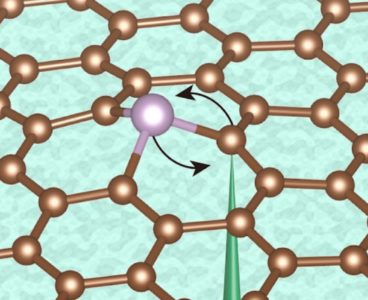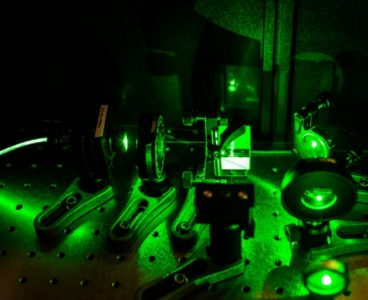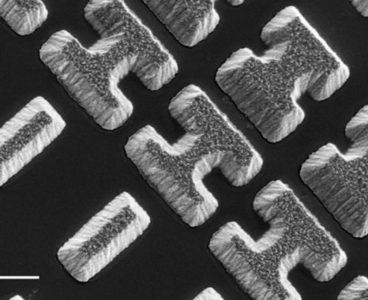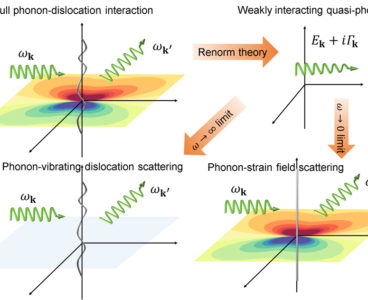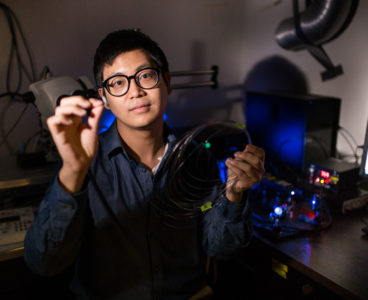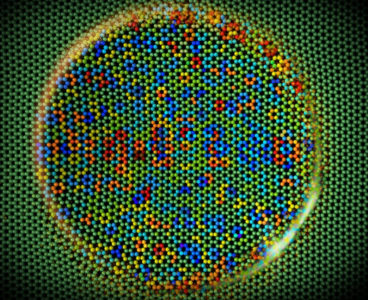The ultimate degree of control for engineering would be the ability to create and manipulate materials at the most basic level, fabricating devices atom by atom with precise control. Now, scientists at MIT, the University of Vienna, and several other institutions have taken a step in that direction, developing a method that can reposition atoms…
Energy Monitor Senses Electrical Failures Before They Happen
A new system devised by researchers at MIT can monitor the behavior of all electric devices within a building, ship, or factory, determining which ones are in use at any given time and whether any are showing signs of an imminent failure. When tested on a Coast Guard cutter, the system pinpointed a motor with…
Minuscule Magnetic Fields Measured with Quantum Sensing Method
A new way of measuring atomic-scale magnetic fields with great precision, not only up and down but sideways as well, has been developed by researchers at MIT. The new tool could be useful in applications as diverse as mapping the electrical impulses inside a firing neuron, characterizing new magnetic materials, and probing exotic quantum physical…
Defects Lead to Amazing Properties in 2D Materials
Amid the frenzy of worldwide research on atomically thin materials like graphene, there is one area that has eluded any systematic analysis—even though this information could be crucial to a host of potential applications, including desalination, DNA sequencing, and devices for quantum communications and computation systems. That missing information has to do with the kinds…
Droplets on the Move Inside of Fibers
Microfluidics devices are tiny systems with microscopic channels that can be used for chemical or biomedical testing and research. In a potentially game-changing advance, MIT researchers have now incorporated microfluidics systems into individual fibers, making it possible to process much larger volumes of fluid, in more complex ways. In a sense, the advance opens up…
Laser Light Pulses, Rather than Heat, Can Trigger Melting
The way that ordinary materials undergo a phase change, such as melting or freezing, has been studied in great detail. Now, a team of researchers has observed that when they trigger a phase change by using intense pulses of laser light, instead of by changing the temperature, the process occurs very differently. Scientists had long…
Soft Hardware Heralds the Future of Textiles
The latest development in textiles and fibers is a kind of soft hardware that you can wear: cloth that has electronic devices built right into it. Researchers at MIT have now embedded high-speed optoelectronic semiconductor devices, including light-emitting diodes (LEDs) and diode photodetectors, within fibers that were then woven at Inman Mills, in South Carolina,…
Creating Better Mid-Infrared Imaging and Sensing
A new way of taking images in the mid-infrared part of the spectrum, developed by researchers at MIT and elsewhere, could enable a wide variety of applications, including thermal imaging, biomedical sensing, and free-space communication. The mid-infrared (mid-IR) band of electromagnetic radiation is a particularly useful part of the spectrum; it can provide imaging in…
New Exotic Phenomena Seen in Photonic Crystals
Topological effects, such as those found in crystals whose surfaces conduct electricity while their bulk does not, have been an exciting topic of physics research in recent years and were the subject of the 2016 Nobel Prize in physics. Now, a team of researchers at MIT and elsewhere has found novel topological phenomena in a…
Ultrafine Fibers Have Exceptional Strength
Researchers at MIT have developed a process that can produce ultrafine fibers — whose diameter is measured in nanometers, or billionths of a meter — that are exceptionally strong and tough. These fibers, which should be inexpensive and easy to produce, could be choice materials for many applications, such as protective armor and nanocomposites. The…
A New Method to Banish Pollutants from Water
When it comes to removing very dilute concentrations of pollutants from water, existing separation methods tend to be energy- and chemical-intensive. Now, a new method developed at MIT could provide a selective alternative for removing even extremely low levels of unwanted compounds. The new approach is described in the journal Energy and Environmental Science, in…
Mapping The Effects of Crystal Defects
New research offers insights into how crystal dislocations — a common type of defect in materials — can affect electrical and heat transport through crystals, at a microscopic, quantum mechanical level. Dislocations in crystals are places where the orderly three-dimensional structure of a crystal lattice — whose arrangement of atoms repeats with exactly the same…
Tiny New Fibers Open New Windows into the Brain
For the first time ever, a single flexible fiber no bigger than a human hair has successfully delivered a combination of optical, electrical, and chemical signals back and forth into the brain, putting into practice an idea first proposed two years ago. With some tweaking to further improve its biocompatibility, the new approach could provide…
Electrons Go Superballistic
A new finding by physicists at MIT and in Israel shows that under certain specialized conditions, electrons can speed through a narrow opening in a piece of metal more easily than traditional theory says is possible. This “superballistic” flow resembles the behavior of gases flowing through a constricted opening, however it takes place in a…
Porous, 3D Graphene is 10 Times Stronger than Steel
A team of researchers at MIT has designed one of the strongest lightweight materials known, by compressing and fusing flakes of graphene, a two-dimensional form of carbon. The new material, a sponge-like configuration with a density of just 5 percent, can have a strength 10 times that of steel. In its two-dimensional form, graphene is…
Graphene is a Work of Science Friction
Graphene, a two-dimensional form of carbon in sheets just one atom in thick, has been the subject of widespread research, in large part because of its unique combination of strength, electrical conductivity, and chemical stability. But despite many years of study, some of graphene’s fundamental properties are still not well-understood, including the way it behaves…
Drive-by Monitoring for Urban Streetlights
Is there a streetlight burned out on your block? Unless you or your neighbors phone the right city department, there’s a good chance nobody knows about it. Most cities don’t have any comprehensive listing or map of where their lights are located, what kind they are, what their expected operational lifetimes are, how high they…
Nanolayered Graphene Composites Inspired by Pastry Dough
Adapting an old trick used for centuries by both metalsmiths and pastry makers, a team of researchers at MIT has found a way to efficiently create composite materials containing hundreds of layers that are just atoms thick but span the full width of the material. The discovery could open up wide-ranging possibilities for designing new,…
Pioneering Mid-infrared Laser Reveals Atmospheric Chemicals
Researchers at MIT and elsewhere have found a new way of using mid-infrared lasers to turn regions of molecules in the open air into glowing filaments of electrically charged gas, or plasma. The new method could make it possible to carry out remote environmental monitoring to detect a wide range of chemicals with high sensitivity.…
Graphene Transforms Electricity Into Light
When an airplane begins to move faster than the speed of sound, it creates a shockwave that produces a well-known “boom” of sound. Now, researchers at MIT and elsewhere have discovered a similar process in a sheet of graphene, in which a flow of electric current can, under certain circumstances, exceed the speed of slowed-down…

